by former Charlotte Observer reporter Gene Stowe
A courtroom battle over ancestral Burleson land in Union County is at the heart of a new book, Inherit the Land: Jim Crow Meets Miss Maggie’s Will, by former Charlotte Observer reporter Gene Stowe. The University Press of Mississippi will publish the book next summer.
The story involves the Jonathan Burleyson home place near the village of Marvin. Jonathan’s will in 1859 left the use of the land to his daughter, Susannah Burleyson Ross, but forbade her husband, Nathan Ross, from entering the land. Susan and her children, Dennis, Sallie and Maggie, bought the rights to the 428 acres from Jonathan’s other heirs in 1868 for $1 an acre. By 1896, when Dennis died as a result of a cotton gin accident, the family had added about 300 acres of adjacent land and another 700 acres of other land, including a prominent house between Banks Presbyterian Church and Marvin Methodist Church.
In 1874, Susan took 2-year-old Bob Ross from h is mother under North Carolina’s apprenticeship law and raised him in her home with her grown children. She died in 1886. When Bob married and had a daughter, Mittie Bell Ross, in 1887, Sallie and Maggie raised her in the home. None of Susan Ross’s children married or had any children. When Sallie and Maggie wrote their wills in 1907, soon after Mittie and her husband Tom Houston had their first child, they left the homeplace land to Bob and Mittie. The other lands were to be sold to pay legacies to a long list of church, charitable institutions and individuals. The women, whose cousin Wal
is mother under North Carolina’s apprenticeship law and raised him in her home with her grown children. She died in 1886. When Bob married and had a daughter, Mittie Bell Ross, in 1887, Sallie and Maggie raised her in the home. None of Susan Ross’s children married or had any children. When Sallie and Maggie wrote their wills in 1907, soon after Mittie and her husband Tom Houston had their first child, they left the homeplace land to Bob and Mittie. The other lands were to be sold to pay legacies to a long list of church, charitable institutions and individuals. The women, whose cousin Wal![]() ter Bickett was governor, were the richest women in the county.
ter Bickett was governor, were the richest women in the county.
Sallie died in 1909. When Maggie died in 1920, the revelation of the will prompted more than 100 relatives – none closer than second cousin and almost all on the Ross side – to contest the bequest. Led by John J. Parker, who had recently lost a race for governor, they claimed that Maggie was obviously crazy or she would not have left her land to black people. Defenders of the will, led by the prominent Charlotte lawyer E.T. Cansler and Monroe Mayor John Sikes, argued that the Ross relations had left these women lonely in their later years and the black people had cared for them, making the bequest natural. After a sensational two-week trial in the Union County Courthouse in Monroe, with more than 100 witnesses, the 12 white men on the jury took only 45 minutes to uphold the will.
 The cousins appealed to the state Supreme Court and won a new trial, but in 1924, another jury took only an afternoon to uphold the will. The black people inherited the land.
The cousins appealed to the state Supreme Court and won a new trial, but in 1924, another jury took only an afternoon to uphold the will. The black people inherited the land.
Over the years, especially during the Great Depression, the family lost much of the land or sold it to raise money or pay taxes. In the early 1990s, the Marvin AME Zion Church that the white women helped start in 1898 bought part of the family land for their new church. The relationships between black and white people that the family established so long ago preserved racial harmony in Marvin during decades when nearby Monroe and other communities were torn by racial strife.
Inherit the Land, based on documents, interviews, family histories and the transcript of the trial, traces the history of the family, the relationships in Marvin, and the very different way that black and white people related in much of the rest of the country. It tracks the trial arguments, the very different ways that the two sides tried to spin the same set of facts about those relationships, and the reaction to the stunning verdict. A closing section brings the reader up to date on the people, the land and the communities involved.
Mr. Gene Stowe is going to meet with members of the Burleson Family Research Group for an afternoon of touring the locations mentioned in his book. All the details have not been worked out, but it will be in the week of June 15, 2006. Anyone interested in joining us please contact JD Burleson, 333 476-1682, or e-mail jdburleson@northstate.net.
WHAT WE KNOW ABOUT JONATHAN BURLESON
RECEIVED FROM JOE RAPER
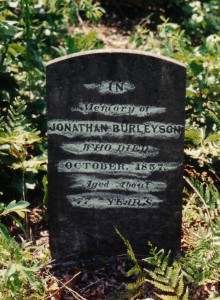 The following land grant will show that Isaac owned land prior to July 2. 1785 in Montgomery County, N.C. located on the waters of Little Bear Creek: File #051 Entry #6248 July 2, 1785
The following land grant will show that Isaac owned land prior to July 2. 1785 in Montgomery County, N.C. located on the waters of Little Bear Creek: File #051 Entry #6248 July 2, 1785
Isaac had a land grant of 10 acres to be surveyed to join his old properly line. It was located on the west side of Yadkin River on waters of Little Bare (Bear) Creek.
JONATHAN BURLESON SHOWN IN EARLY NORTH CAROLINA CENSUS
CENSUS OF 1790 MONTOGOMERY COUNTY, NORTH CAROLINA
1790 CENSUS WITH ISAAC 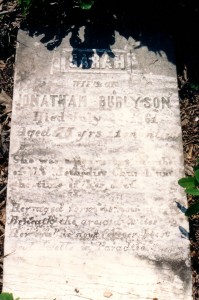 BURLISON AS HEAD OF HOUSEHOLD:
BURLISON AS HEAD OF HOUSEHOLD:
ONE MALE 16+………….ISAAC SR…..B1750
ONE MALE UNDER 16…JONATHAN…B1781
ONE MALE UNDER 16…ISAAC JR. …..B1784
ONE FEMALE………MARTHA……B AFTER 1755.WIFE OF ISAAC
ONE FEMALE……………UNKNOWN….B 1785-1790
ONE FEMALE……………UNKNOWN….B 1785-1790
CENSUS OF 1800 MONTOGOMERY COUNTY, NORTH CAROLINA;![]()
1800 CENSUS WITH ISAAC BURLEYSON SR. AS HEAD OF HOUSEHOLD:
ONE MALE 45+………….….ISAAC SR…..B1750
ONE MALE 16-26…….……JONATHAN…B1781
ONE MALE 16-26…….……ISAAC JR……B1784
ONE FEMALE 26-45….MARTHA……B AFTER 1755.WIFE OF ISAAC
ONE FEMALE10-16…………UNKNOWN….B 1785-1790
ONE FEMALE10-16…………UNKNOWN….B 1785-1790
ONE FEMALE UNDER 10….JANE…………B 1792
ONE FEMALE UNDER 10….UNKNOWN….B 1791-1800
ONE FEMALE UNDER 10…UNKNOWN…..B 1791-1800
CENSUS OF 1810 MONTOGOMERY COUNTY, NORTH CAROLINA;
1810 CENSUS WITH JONATHAN AS HEAD OF HOUSEHOLD(LISTED JNO BURLESTON)
ONE MALE 26-45…….…JONATHAN..…B1781
ONE MALE UNDER 10…DENNIS. ………B1805
ONE FEMALE 26-45….…….SARAH.……B 1784/85….WIFE
ONE FEMALE UNDER 10….MARY………B 1792
ONE FEMALE UNDER 10….SUSANNAH …B 1792
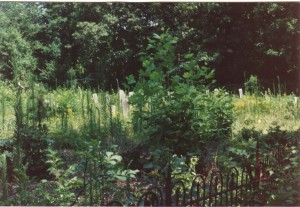 The earliest mention of Jonathan by name occurs in January 1808 when he files for a land grant which adjoins Isaac Burlison’s (Sr.) property.
The earliest mention of Jonathan by name occurs in January 1808 when he files for a land grant which adjoins Isaac Burlison’s (Sr.) property.
File No. 1832, Montgomery County, North Carolina, Jonathan Burleson, 77 acres, Grant No. 2160, Issued 15 December 1809, Entry No. 6545, Entered 5 January 1808, Book No. 125, Page No. 256.
To the Surveyor of sd County Greeting. You are hereby required to lay off a Survey allowing to law for Jonothan Burlingson a tract or parcel of land containing seventy seven acres on each side of the Running branch of little Bare Creek joining Isaac Burlison and Nathan Almond lines including his own improvement and return the same in two fair plans agreeable to an Act of Assembly made and provided in such cases given under my hand at office—the 5`h day of January 1808.
(Jos) Parsons ET
No. 6545
This plat represents Seventy seven acres of land in Montgomery County on Each sid of Runing branch of little Bair Creek Beginning on Isaac Burleyson’s line at a Red oak and runs South Seventy-five East Seventy poles to a Red oak by a white oak thence South thirty three West 150 poles to a pine thence West Sixty poles to a Stake thence S thirty-one West Eight poles to Nathan Almonds line thence with said line South 67 west Eighty poles thence North Six west 94 poles to the first Station Surveyd for Jonathan Burlison this 23 day of November 1808.
Jas. Chappell, Surveyor
Isaac Burleysan CC (Chain carriers)
Joseph P. Wifliams) The preceding Land Grant and Census Reports indicates (in my opinion) that Jonathan is the oldest son of Isaac Sr. and Martha and that at the time of this land grant entry (January 5 1808) Jonathan was 27 years old and had been married to Sarah for about three and half years (since Dennis was born September 21, 1805). Jonathan’s acquisition of the property adjoining Isaac Sr. and with Isaac Sr. being a Chain Carrier in the Survey suggests a family relationship. Seems as though Jonathan started his family next door to his Dad and Mom. Entry No. 6622 Grant No. 2202 Nov. 24,1808 Isaac Jnr. (Jonathan’s younger brother b.1754) was involved in receiving a land grant. It consisted of a parcel (50 acres) of land located on the waters of Long Creek and Little Bear Creek. This land joined the properties of his father Isaac and that of neighbor, Isaac Cooper. September 25, 1818 Jonathan Burleyson acquires 10 acres of land on Twelve Mile Creek.
JONATHAN AND SARAH’S CHILDREN:
Dennis Clay was born September 2, 1805 and married Sarah M. Bonds most likely in 1828 .. They left Mecklenburg County in the 1830`s and went to Lafayette County, Mississippi via Lancaster County, South Carolina, “Three daughters were born in Mecklenburg County. two sons in Lancaster County, three daughters and one more son in Lafayette County, Mississippi. Dennis died in Lafayette County, Mississippi sometime between 1863 and 1869 and is buried in an unknown location.
Mary Burleyson was born about 1807 and married a man named Stewart. Nothing else is known except that she was deceased prior to 1852.
Susannah Burleyson was born June 20, 1809 and married Nathaniel Ross in 1827. They had five children, three boys and two girls. Susan was their only child who remained in North Carolina on Jonathan and Sarah’s property . Susan died November 20, 1886. Susan`s descendants finally left the property to descendants of Jonathan and Sarah’s slaves.
John B. Burleyson was born April 16, 1811 and married Esther Adams most likely in 1835 in Mecklenburg County NC. They left North Carolina in 1841 and went to Mississippi. Two if their children were born in North Carolina (boys) and three more were born in Mississippi (2 boys, 1 girl). Esther died sometime between 1851 and 1858. In 1858 John married Ellen and they had two girls and one boy. Ellen’s last name not known. John lived in Panola, Tunica, and Quitman Counties while in Mississippi. He died Oct.12,1880 and was buried in Belen, Quitman, County, MS. Margaret A. Burleyson was born March 29,1819 and married sometime between 184 1-42. She married a man named Gribble and they had two sons before Margaret’s early death on January 28. 1847. She is buried in Union County. N.C. near her parents.
Jasper Jonathan Burleyson was born in 1826 in Mecklenburg County, N.C. he appeared on Jonathan’s will and on the 1850 Census of Panola County, MS. In Mississippi, he was living with his brother John . No further record on him.
This book will be available at the Burleson Family Association, Board of Directors, and Reunion in Ashville, NC. The 800 acre plantation belonged to Jonathan Burleson, Maggie and Sallie were his granddaughters.
Inherit the Land, Jim Crow Meets Miss Maggie’s Will
I received this from Gene Stowe
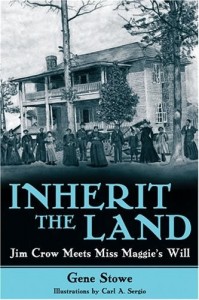 The picture is drawn from an 1898 photograph that was evidence in the trial. A descendant of the black family found it behind his baby picture in an old frame and asked the historical society to help identify it just at the time I was trying to get enough material to make the book nonfiction.
The picture is drawn from an 1898 photograph that was evidence in the trial. A descendant of the black family found it behind his baby picture in an old frame and asked the historical society to help identify it just at the time I was trying to get enough material to make the book nonfiction.
The house is a historic property in Mecklenburg County now. It was built by Dr. J.J. Rone, and the Rosses bought it from him. Then they left it to Banks Church, which had no use for it, and Rone’s grandson, Sam Ardrey (who died not long ago) moved it across Sixmile Creek in 1964. It has been moved again, still west of Sixmile Creek, more reently to make room for a subdivision on Ardrey’s old cattle farm. You can find a full description in the Charlotte-Mecklenburg Historic Properties…Google “Rone House.”
Mr. Gene Stowe will meet with members of the BFRG on Friday June 16, 2006. We are going to film the meeting and he is going to show us all the interesting points of interest, the cemeteries, and the location of Jonathan Plantation. He will also provide us with an insight on how the book came about and how he found out about it. We encourage anyone interested in this to make plans to attend. We are meeting at 1:00PM in the cemetery across the street from Banks Presbyterian Church, 10012 Newtown Road, Waxhaw, NC
Editorial Reviews Book Description
In the early twentieth century, two wealthy white sisters, cousins to a North Carolina governor, wrote identical wills that left their substantial homeplace to a black man and his daughter. Maggie Ross, whose sister Sallie died in 1909, was the richest woman in Union County, North Carolina. Upon Maggie’s death in 1920, her will bequeathed her estate to Bob Ross—a black man who had grown up in the sisters’ household—and his daughter Mittie Bell Houston. Mittie had also grown up with the well-to-do white women, who had shown their affection for her by building a house for her and her husband. This house, along with eight hundred acres, hundreds of dollars in cash, and two of the white family’s three gold watches went to Bob Ross and Houston. As soon as the contents of the will became known, more than one hundred of Maggie Ross’s scandalized cousins sued to break the will, claiming that its bequest to black people proved that Maggie Ross was mentally incompetent. Revealing the details of this case and of the lives of the people involved in it, Gene Stowe presents a story that sheds light on and complicates our understanding of the Jim Crow South. Stowe’s account of this famous court battle shows how specific individuals, both white and black, labored against the status quo of white superiority and ultimately won. An evocative portrait of an entire generation’s sins, Inherit the Land hints at the possibility for color-blind justice in small-town North Carolina.
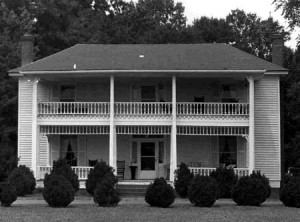 This is the house that Maggie and Sallie lived in and left to the Banks Church in their wills.
This is the house that Maggie and Sallie lived in and left to the Banks Church in their wills.
